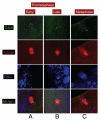Cdc6 is required for meiotic spindle assembly in Xenopus oocytes
- PMID: 22262174
- PMCID: PMC3315094
- DOI: 10.4161/cc.11.3.19033
Cdc6 is required for meiotic spindle assembly in Xenopus oocytes
Abstract
During the maturation of Xenopus oocytes, Cdc6 expression is necessary to establish replication competence to support early embryonic DNA replication. However, Cdc6 is expressed before the completion of MI, at a time when its function as a replication factor is not required, suggesting additional roles for Cdc6 in meiosis. Confocal immunofluorescence microscopy revealed that Cdc6 protein was distributed around the spindle precursor at the time of germinal vesicle breakdown (GVBD), and localized to the margin of the nascent spindle early in prometaphase. Cdc6 subsequently localized to spindle poles in late prometaphase, where it remained until metaphase arrest. Microinjection of antisense oligonucleotides specific for Cdc6 mRNA disrupted spindle assembly, resulting in defects including delayed spindle assembly, misoriented and unattached anaphase spindles, monasters, multiple spindles, microtubule aggregates associated with condensed chromosomes, or the absence of recognizable spindle-like structures, depending on the level of residual Cdc6 expression. Furthermore, Cdc6 co-localized with γ-tubulin in centrosomes during interphase in all somatic cells analyzed, and associated with spindle poles in mitotic COS cells. Our data suggest a role for Cdc6 in spindle formation in addition to its role as a DNA replication factor.
Figures





Similar articles
-
CDC6 regulates both G2/M transition and metaphase-to-anaphase transition during the first meiosis of mouse oocytes.J Cell Physiol. 2020 Jul;235(7-8):5541-5554. doi: 10.1002/jcp.29469. Epub 2020 Jan 26. J Cell Physiol. 2020. PMID: 31984513
-
Spindle formation and dynamics of gamma-tubulin and nuclear mitotic apparatus protein distribution during meiosis in pig and mouse oocytes.Biol Reprod. 2000 May;62(5):1184-92. doi: 10.1095/biolreprod62.5.1184. Biol Reprod. 2000. PMID: 10775165
-
Gamma-tubulin is required for bipolar spindle assembly and for proper kinetochore microtubule attachments during prometaphase I in Drosophila oocytes.PLoS Genet. 2011 Aug;7(8):e1002209. doi: 10.1371/journal.pgen.1002209. Epub 2011 Aug 11. PLoS Genet. 2011. PMID: 21852952 Free PMC article.
-
The chromosomal basis of meiotic acentrosomal spindle assembly and function in oocytes.Chromosoma. 2017 Jun;126(3):351-364. doi: 10.1007/s00412-016-0618-1. Epub 2016 Nov 11. Chromosoma. 2017. PMID: 27837282 Free PMC article. Review.
-
Cdc6: a multi-functional molecular switch with critical role in carcinogenesis.Transcription. 2012 May-Jun;3(3):124-9. doi: 10.4161/trns.20301. Transcription. 2012. PMID: 22771947 Free PMC article. Review.
Cited by
-
The DNA replication protein Cdc6 inhibits the microtubule-organizing activity of the centrosome.J Biol Chem. 2017 Sep 29;292(39):16267-16276. doi: 10.1074/jbc.M116.763680. Epub 2017 Aug 21. J Biol Chem. 2017. PMID: 28827311 Free PMC article.
-
Mathematical Model Explaining the Role of CDC6 in the Diauxic Growth of CDK1 Activity during the M-Phase of the Cell Cycle.Cells. 2019 Nov 28;8(12):1537. doi: 10.3390/cells8121537. Cells. 2019. PMID: 31795221 Free PMC article.
-
Systems-level quantification of division timing reveals a common genetic architecture controlling asynchrony and fate asymmetry.Mol Syst Biol. 2015 Jun 10;11(6):814. doi: 10.15252/msb.20145857. Mol Syst Biol. 2015. PMID: 26063786 Free PMC article.
-
Zebrafish cdc6 hypomorphic mutation causes Meier-Gorlin syndrome-like phenotype.Hum Mol Genet. 2017 Nov 1;26(21):4168-4180. doi: 10.1093/hmg/ddx305. Hum Mol Genet. 2017. PMID: 28985365 Free PMC article.
References
-
- Sutton WS. On the morphology of the chromosome group in Brachystola Magna. Biol Bull. 1902;4:24–39. doi: 10.2307/1535510. - DOI
-
- Sutton WS. The chromosomes in heredity. Biological Bulletin. Marine Biological Laboratory. 1903;4:231–251. doi: 10.2307/1535741. - DOI
-
- Farmer JB, Moore JES. On the maiotic phase (reduction divisions) in animals and plants. Q J Microsc Sci. 1905;48:489–557.
Publication types
MeSH terms
Substances
LinkOut - more resources
Full Text Sources
